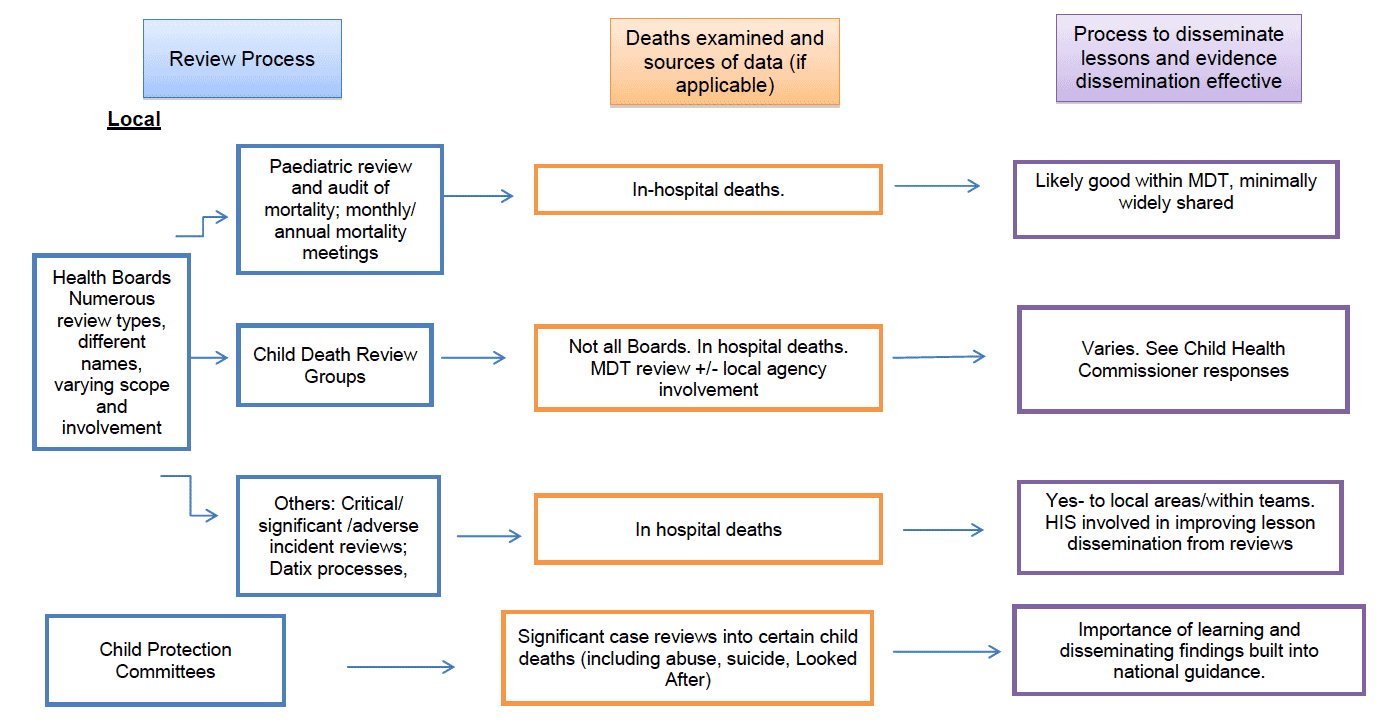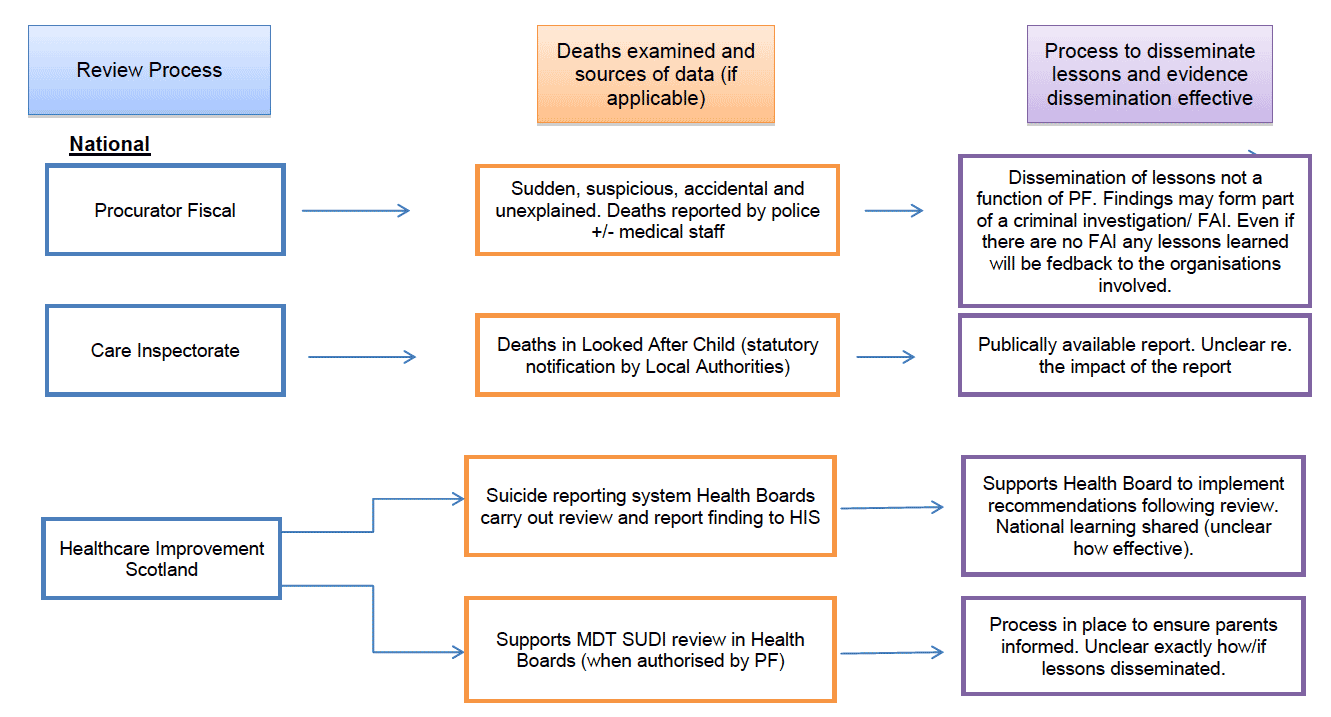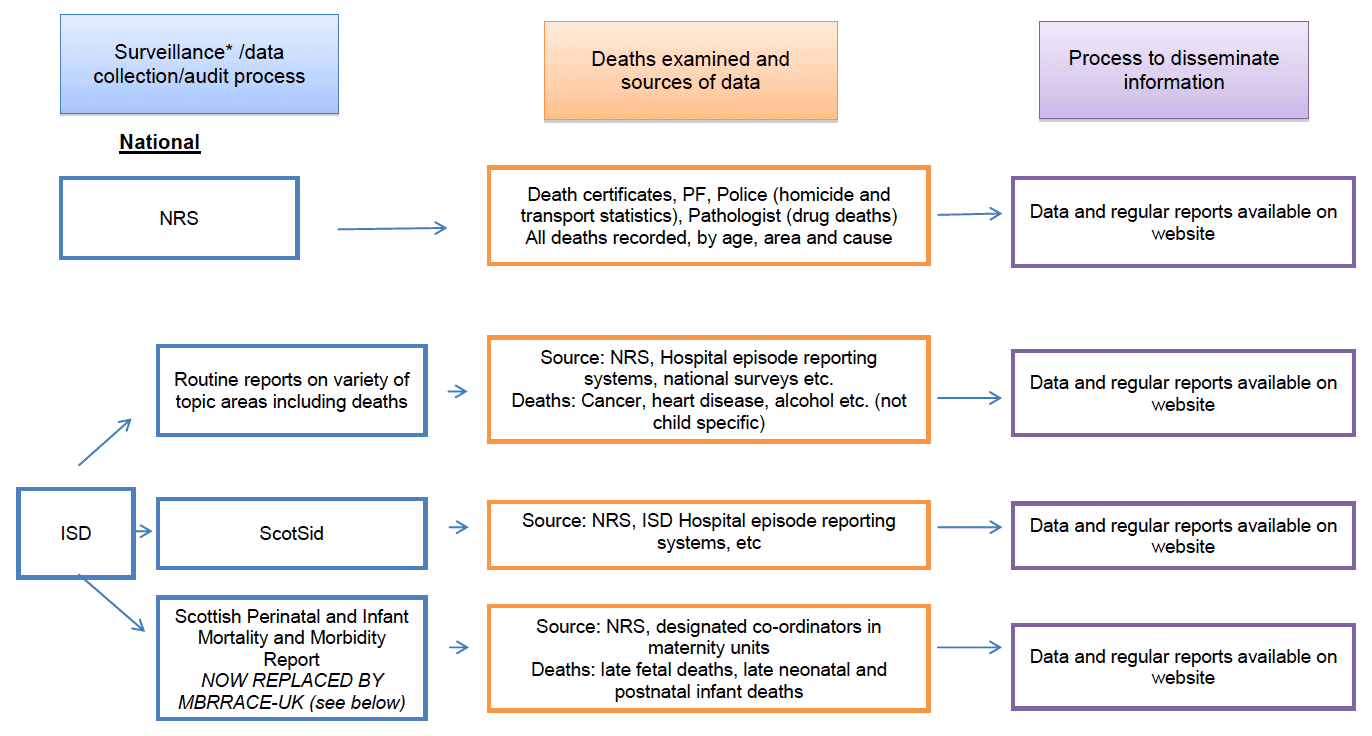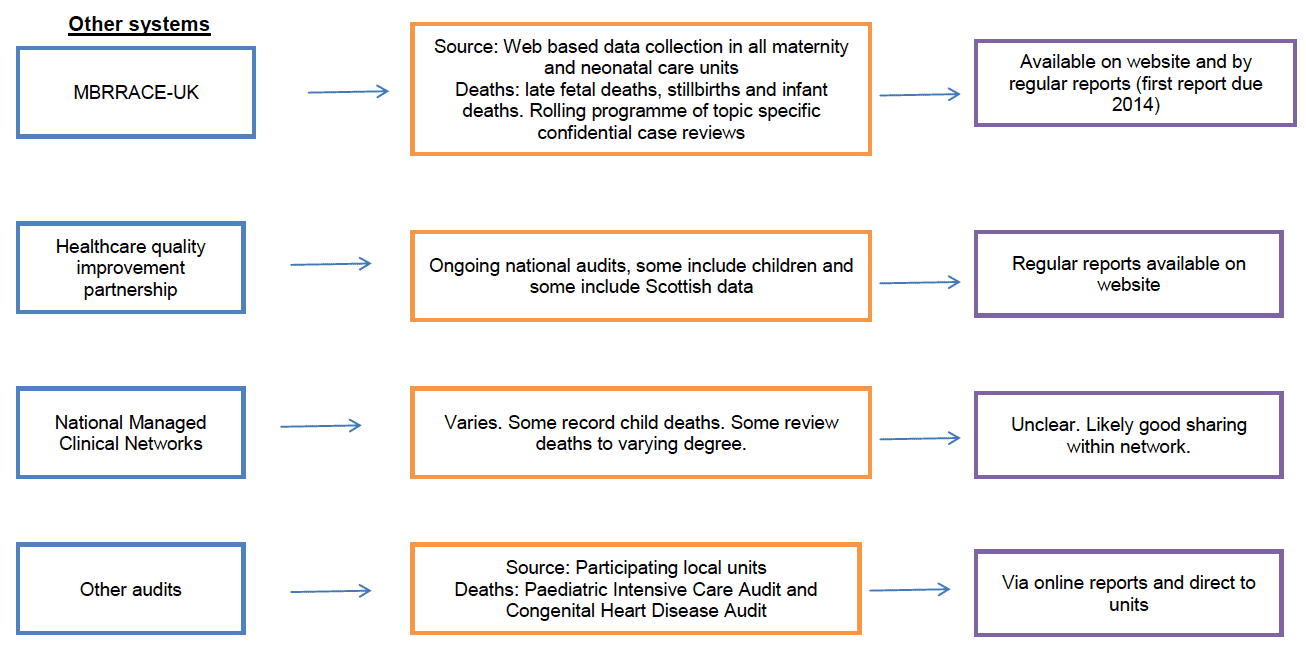Child Death Review Report : Scottish Government Child Death Review Working Group
A report by a Scottish Government short-life working group which explored current practice in Scotland and considered whether Scotland should introduce a national collaborative multi-agency system for reviewing the circumstances surrounding the death of a child.
Appendix 3: Review and surveillance processes in Scotland
Abbreviations: MDT, multi-disciplinary team; HIS, Healthcare Improvement Scotland; SUDI, Sudden and unexpected death in infancy; NRS, National Records of Scotland; ISD, Information Services Division; PF, Procurator Fiscal; ScotSid, Scottish Suicide Information Database; MBRRACE-UK, Mothers and Babies Reducing Risk through Audit and Confidential Enquiries across the UK
Local and National child death review processes in Scotland diagram


National child death data collection and surveillance systems including audit diagram


*Surveillance definition: gathering, analysing, and interpreting data and disseminating findings
Child death review processes- text to accompany above diagrams
1. Interviews with healthcare staff (including Child Health Commissioners, a Paediatric Pathologist, a Consultant in Public Health Medicine and a Paediatrician) and a written survey of all Child Health Commissioners in Scotland reveal there are numerous varied review processes occurring in Health Board areas following the death of a child. Critical/significant/adverse incident reviews occur in all Boards and it appears that lessons learnt are shared effectively within local teams. Some Boards have specific "Child Death Review groups" but these vary in terms of scope, membership and lesson dissemination. Many Boards have regular audits of mortality (including Paediatric review and audit of mortality) and whilst lessons are shared effectively within teams there appears to be less sharing more widely.
2. The diagram also details national level review processes which occur following the death of a child, including investigation by the Procurator Fiscal after certain deaths, review by the Care Inspectorate following the death of a looked after child, specific suicide and sudden and unexpected deaths in infancy (SUDI) reviews led by Healthcare Improvement Scotland (HIS) and the significant case reviews carried out by local multi-agency child protection committees for certain child deaths. Common to most of these reviews is the lack of evidence that lessons learned are effectively shared more widely.
3. The SUDI Review29 is a multidisciplinary case discussion which is held after the final post-mortem examination report is available which may be several months after the infant has died. The process involves assessing the circumstances of the death, including detecting possible causes or contributing factors, with the aim of identifying what lessons can be learned. Additionally, support for the family is considered, particularly in relation to future pregnancies.
4. The group is generally made up of a paediatrician, pathologist, GP, health visitor, community midwife, social worker and any other professional relevant to that particular infant death. Boards have a responsibility to ensure that the meeting takes place with the appropriate professional and that the SUDI Review summary sheet is completed and sent to HIS.
5. No Boards have a specific multi-agency group which reviews all child deaths. The closest to this are the Significant Case Reviews carried out by the local Child Protection Committees. The Scottish Government requires every Local Authority area to have a Child Protection Committee, bringing together key agencies that work with children and their families. Child Protection Committees do not have a statutory basis, however their role and functions are set out in the national guidance. They consist of representatives from a range of backgrounds including the police, health services, local authorities, children services and relevant voluntary agencies. Child Protection Committees have the overall strategic role for the continuous improvement of child protection policy and practice in their local areas. This includes carrying out Significant Case Reviews after significant events. These significant events include child deaths where:
- Abuse or neglect is known or suspected to be a factor in the child's death
- The child is on, or has been on the Child Protection Register or a sibling is or was on the Child Protection Register
- The death is by suicide or accidental death
- The death is by alleged murder, culpable homicide, reckless conduct, or an act of violence
- The child was Looked After by the Local Authority30
6. The importance of learning from significant case reviews is built into national guidance30. However, it is unclear how effective this is as there is no evidence either way.
Data collection and surveillance systems
7. The diagram details the work carried out by the National Records of Scotland (NRS) in collecting data on the number and cause of deaths in Scotland. The Information Services Division (ISD) carries out a number of surveillance roles and reports may include child deaths. Additionally it hosts the Scottish Suicide Information Database which will include child suicides when they occur.
8. The UK wide MBRRACE-UK (Mothers and Babies Reducing Risk through Audit and Confidential Enquiries across the UK) collaboration was appointed by the Healthcare Quality Improvement Partnership (HQIP) to provide a national programme of work investigating maternal deaths, stillbirths and infant deaths, including the Confidential Enquiry into Maternal Deaths15. MBRRACE-UK will collect data from all maternity and neonatal care units about maternal deaths, stillbirths and infant deaths.
9. MBRRACE-UK replaces the ISD Scottish Stillbirth and Infant Death Survey. All units in Scotland are now registered for the web based data collection process. Scottish data will be separately analysed in addition to the UK report and will be used to inform the new patient safety programme in maternity services - the Maternity and Children's Quality Improvement Collaborative3 - and the Early Years Collaborative as well as to inform units at a local level2.
10. There are other national and local audits occurring which may include child deaths, for example audits of various health issues from HQIP and from the national and local managed clinical networks. Reports are often made available online but the extent to which learning points or issues are disseminated more widely is unclear.
Contact
Email: Mary Sloan
There is a problem
Thanks for your feedback